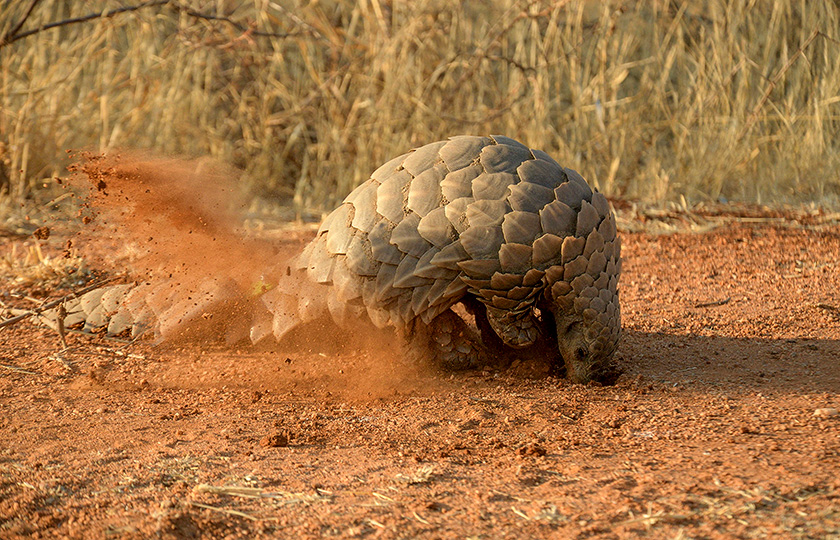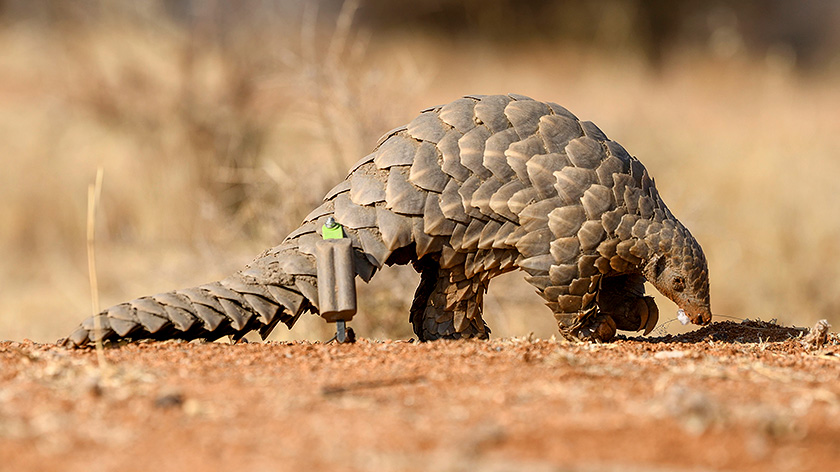The pangolin is one of the rarest and most trafficked mammals on Earth. In Asia, its scales are sold at high prices. These animals are under strict protection, but there are still places where you can observe them with some luck.
Sniff, sniff. The sniffling is getting closer. We’re lying on the dusty ground of the Okonjima Nature Reserve. It’s still early, just after six in the morning. Overnight, it has cooled down to five degrees in the Southern winter, and the sand is still cold. But there’s movement in the bushes. After minutes of waiting, listening, and anticipation, a modern-day dinosaur trundles out of the bushes. It is covered in scales, walks upright on its back feet with its impressive front claws clasped in front of it and using its long wide tail for balance. It keeps checking if there are any ants or termites to be found in the sand.

The pangolin is one of the rarest and most trafficked mammals on Earth
Together with AfriCat’s field researcher we are in search of one of the rarest animals in Africa. This individual, nicknamed Trex, is an eight-month-old male. Without his GPS tracker, affixed to collect research data on his movements, we would probably never have found him. But now, he’s sniffing around everywhere, just a few meters away from us, as if we don’t exist. Trex repeatedly sticks his nose into holes in the ground to search for ants and termites. When he finds something, he slips his tongue into the burrow to capture the prey. Pangolins have one of the longest tongues in the animal kingdom relative to their body size, second only to chameleons. Without it, they wouldn’t stand a chance of reaching their often deep-in-the-ground prey.
Many people have never even heard of a pangolin and most have never seen one. These animals are so rare, and sightings are even rarer. The oldest known relatives of today’s pangolins lived about 47 million years ago. Trex is a Temminck’s Ground Pangolin (scientific name: Smutsia temminckii). The ground pangolin is the only species of pangolin that occurs in Namibia. It is the second largest of all the pangolin. Trex is a young adult, weighing 9kg according to AfriCat. Adult pangolin weigh between 8-18kg. He was only recruited into the AfriCat research programme in March 2022, although his mother has been in AfriCat’s research programme since 2018.
In terms of appearance, the pangolin could indeed have come from a prehistoric fairy tale. These primarily nocturnal insectivores are the last survivors of a millions-of-years-long evolutionary process. Their bodies are covered in hard and sharp scales made of keratin, their tongues are longer than their body length and are attached near the pelvis and the last pair of ribs.

AfriCat´s researcher checks on Trex’s well-being several times a week and records data on his location and behavior.
Today, there are eight known species of pangolins, four in Africa and four in Asia. What they all have in common is that their populations have declined significantly due to illegal hunting. The International Union for Conservation of Nature (IUCN) has classified three Asian species as “Critically Endangered,” and one as “Endangered.” The situation for the four African species is not much better, as populations of ground pangolins, white-bellied pangolins, giant pangolins, and long-tailed pangolins are also dramatically decreasing. Two of the four African species are listed as “Endangered,” and two as “Vulnerable,” including the ground pangolin.
The problem is that in many parts of Africa, their meat is considered a delicacy and is sold as “bushmeat” in local markets. Moreover, various body parts are attributed with medical efficacy against diseases, particularly in West, Central, and East Africa. However, the global trade poses an even greater threat to pangolins. The trade to Asia, where pangolins are commonly used in traditional Chinese medicine, is thriving. As rhinoceros horn becomes scarcer, ground pangolin scales are increasingly used as a substitute in Chinese medicine, for purposes such as an aphrodisiac, asthma remedy, and treatment for rheumatism and cancer.
The four Asian species have been protected under the Convention on International Trade in Endangered Species of Wild Fauna and Flora (CITES) since 2000. Since 2017, all eight species are listed under CITES Appendix I, enjoying the highest level of protection. International trade in these animals is completely prohibited. Nevertheless, they continue to be hunted. No one knows exactly how many tons of pangolin scales are smuggled annually. According to the World Wide Fund for Nature (WWF), at least 300 pangolins are hunted worldwide every day, totaling around 10,000 per year, despite the fact that a pangolin mother gives birth to only one offspring per year. According to the Namibian Pangolin Conservation and Research Foundation 491 pangolin have been confiscated (152 live and 339 carcasses or skins) and 640 perpetrators have been arrested over the last seven years in Namibia.
Because of their vulnerability to poaching, safe habitat for pangolin is crucial for their survival. The Okonjima Nature Reserve in one such safe habitat. The AfriCat Foundation, which operates in the Reserve, initiated its own research in 2018 in order to monitor the pangolins in the Reserve and learn more about them. Registered in 1993, the Foundation’s original goal was the protection and conservation of predators as they are most at risk of human-wildlife conflict. The Foundation’s focus has now expanded to endangered species.

Together with AfriCat’s field researcher we are in search of one of the rarest animals in Africa. On the left: AfriCat´s director Karen Codling.
For a long time, the AfriCat Foundation was known for its work with farmers to mitigate conflict between livestock farmers and predators, in particular cheetah and leopard. However, farmers were unable or unwilling to adapt farming methods and instead requested the Foundation’s assistance to remove unwanted predators. Initially AfriCat was able to relocate the cheetahs and leopards to farms willing to accommodate them but it became increasingly difficult to find alternative territory for them. Moreover, removing predators from farmland is not a solution as new individuals quickly arrive to take up the vacant territory. AfriCat therefore stopped working on human wildlife conflict and is instead focused on researching the contribution that enclosed protected areas can make to environmental conservation.
AfriCat’s research includes studying ground pangolin naturally occurring in the protected Okonjima Nature Reserve. “As part of the research the Foundation has tagged a number of pangolin and installed motion-triggered cameras at their burrows. We are collecting data on their basic ecology because so little is known about these animals. For example, we are trying to find out the size of their territories, breeding and reproductive behavior, and how the animals interact with each other and other species in the Reserve,” says Karen Codling, AfriCat’s Director. Pangolins are very sensitive animals. For example, during drought, which is common in Namibia, the Foundation recorded increased pangolin mortality because of reduced termite availability; termites are the primary food source for these creatures, alongside ants. “The goal of our research is to promote understanding of pangolins and enhance their protection. Our work is mostly funded by tourism,” says Codling.
AfriCat’s field researcher has been tracking the Trex since its birth. He lovingly calls Trex his “son.” He checks on Trex’s well-being several times a week and records data on his location and behavior. Periodically, the animal is measured, weighed, and examined for its health. The researchers have recorded significant fluctuations in his weight, frequent burrow changes and the use of a burrow that was used by his mother prior to his birth. As he is a young pangolin, we are particular interested in his dispersal behavior away from his mother and how he is choosing to establish a territory,” says Codling. “The presence of pangolins is always a good sign for a healthy ecosystem,” says Codling. “They are considered an indicator species.” It’s also known that despite their small size, pangolins are crucial for the ecosystem. One pangolin can consume up to 70 million termites in a year.
One of the significant threats to the ground pangolin, in addition to illegal trade, is electrified fences. Farmers and wildlife owners use these as a means of protecting their animals and they usually include an electrified wire, close to the ground that the pangolin walk over causing their electrocution and death. A South African study estimated 1,000-2,000 pangolin deaths per year as a result of electric fences; far greater than the number of pangolins trafficked or poached. The experience has been different on Okonjima however, despite the 96km of electrified fence in the Reserve. The Okonjima Nature Reserve was fenced in 2011 and specific adjustments were made to traditional fence design to reduce the chances of wildlife being killed or injured by the fence. This includes raising the bottom electric wire higher off the ground and adding an earth wire and a further electric wire at chest height of large antelopes to prevent them from fighting through the fence. As the bottom wire is quite high off the ground, animals such as porcupine and warthogs are able to dig under the fence. The entire fence line is therefore checked daily to close off any of these holes. But the strategy has been effective at preventing pangolin, as well as tortoise and aardvark, deaths due to electrocution on the fence.
Pangolins can usually defend themselves well against most predators. For instance, when a lion or leopard gets too close to a pangolin, it rolls itself up into a protective ball. In such cases, even a lion usually realizes that there’s no prey to be had. However, this defense strategy is useless against humans and as long as they have a commercial value, dead or alive, they will continue to be poached and trafficked. The Okonjima Nature Reserve is providing safe habitat for the pangolin in the Reserve and the AfriCat Foundation is collecting vital information to support their conservation throughout Namibia and beyond.
Text and Photos: Fabian von Poser, Karen Codling
As some of the pangolins at Okonjima are equipped with tracking devices for research purposes, the chances of observing the animals are quite good. To help finance the protection and research on the pangolin, Okonjima offers special tours. The “Pangolin Tracking on foot” tour with up to six guests lasts for two hours, with a maximum of 30 minutes spent observing the pangolin. However, this excursion is only available to guests staying for at least two nights. The tour costs between 2,000 and 2,200 Namibian dollars (2023 rates), depending on the season, equivalent to about 110 to 125 euros. Children aged 12 and 13 pay half the price. This activity is subject to availability and bookings can be made directly at the Lodge.
